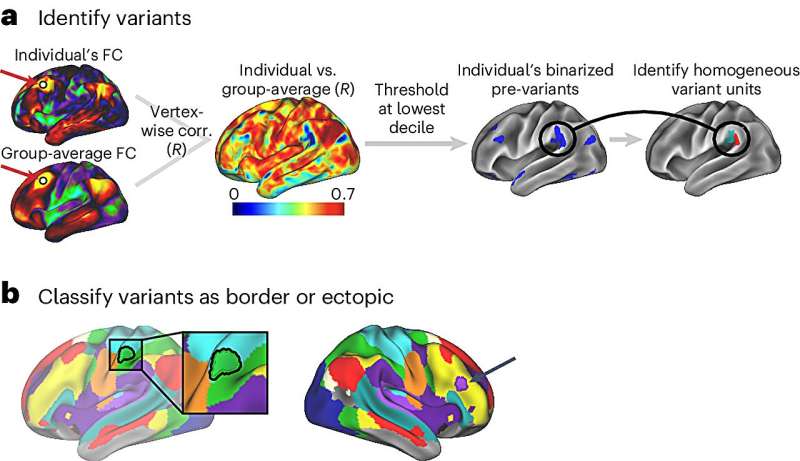This article has been reviewed according to Science X's editorial process and policies. Editors have highlighted the following attributes while ensuring the content's credibility:
fact-checked
peer-reviewed publication
trusted source
proofread
Neuroscientists discover two specific brain differences linked to how brains respond during tasks

A new study by neuroscientists at Florida State University has revealed brain differences that may explain why humans demonstrate a variety of cognitive abilities and behaviors.
The research, conducted by a multi-institution team led by FSU Associate Professor of Psychology and Neuroscience Caterina Gratton and research technician Ally Dworetsky, shows that two forms of individual differences may predict cognitive abilities, explain behavioral differences and even pinpoint biomarkers of brain disease.
"We discovered that in addition to individual brain differences located along the borders of brain regions, such as the border between visual and parietal regions of the brain, individual differences can also occur in a different way. Some variations are further away from where you would expect, popping up like islands," said Dworetsky, a research assistant in the Gratton Lab and the study's lead author. "We call these ectopic intrusions since they occur in unexpected locations."
The study, in coordination with colleagues at Washington University in St. Louis, Johns Hopkins School of Medicine, University of Oxford and the University of Nebraska-Lincoln, is published in the journal Nature Neuroscience.
"This research reconceptualizes how we think about how brains can differ from one another and what these differences mean," Gratton said. "Additionally, this helps us approach new research questions such as how these differences affect brain development, behavioral traits, the development of disorders and more."
With a more complete understanding of what is happening in the brain, researchers can better assess the mechanisms underlying what leads brains to differ from one another, which supports the study of brain disorders and diseases such as Parkinson's disease, an area of research that Gratton has pursued for years.
"This collaboration is a continuation of a previous study on trait-like variants in human functional brain networks that was published in the Proceedings of the National Academy of Sciences in 2019," Dworetsky said. "The goal of these studies is to better understand how individual differences in the brain manifest in people and reconceptualize how variability in the brain may link to differences in cognition and behavior."
This recent study, titled "Two common and distinct forms of variation in human functional brain networks," is unique in how it approaches brain network variations, because previous work on this topic treated individual differences as equivalent and primarily linked to boundary shifts between the borders of brain regions. Identifying additional individual differences in the form of ectopic intrusions helps researchers better understand how each of these differences manifests and how the brain functions normally.
By taking extensive measures of individuals, including scanning the brains of individuals 10 or more times using functional MRI scanning, researchers can reliably identify these locations and obtain more detailed characterizations relative to what is possible with more typical approaches. This data was used to develop methods that identify the border shifts and ectopic intrusions.
"What we found when looking at the data is that the ectopic variants are a quite common phenomenon—it's more frequent than we expected to have these unusual locations of variations," Gratton said. "This means we need to think about mechanisms for how the brain can differ that may cause long-range changes in both the connectivity and function between different brain regions."
Dworetsky, who earned her bachelor's degree in 2018 from Washington University in St. Louis and joined the Gratton Lab in 2020, worked to show that both border shifts and ectopic variants also differ in many ways: they are located in different parts of the brain, they interconnect with different brain systems, and they differ across samples that are genetically similar.
"We learned that separating border shifts and ectopic intrusions can be very informative in our understanding of how these individual differences occur in our brain and also what they may tell us about how the brain functions," Dworetsky said.
With team members from collaborating institutions specializing in various analyses, ranging from using machine learning techniques to predict demographic and behavioral variables from brain data to heritability and genetic analysis, the researchers were able to better understand genetic and environmental factors and how they played out in the manifesting of brain differences.
"We plan to dig into the cognitive variables that we predict will be affected by these differences, especially to see if these differences can be predictive in certain brain disorders," Gratton said of forward-looking research.
More information: Ally Dworetsky et al, Two common and distinct forms of variation in human functional brain networks, Nature Neuroscience (2024). DOI: 10.1038/s41593-024-01618-2





















